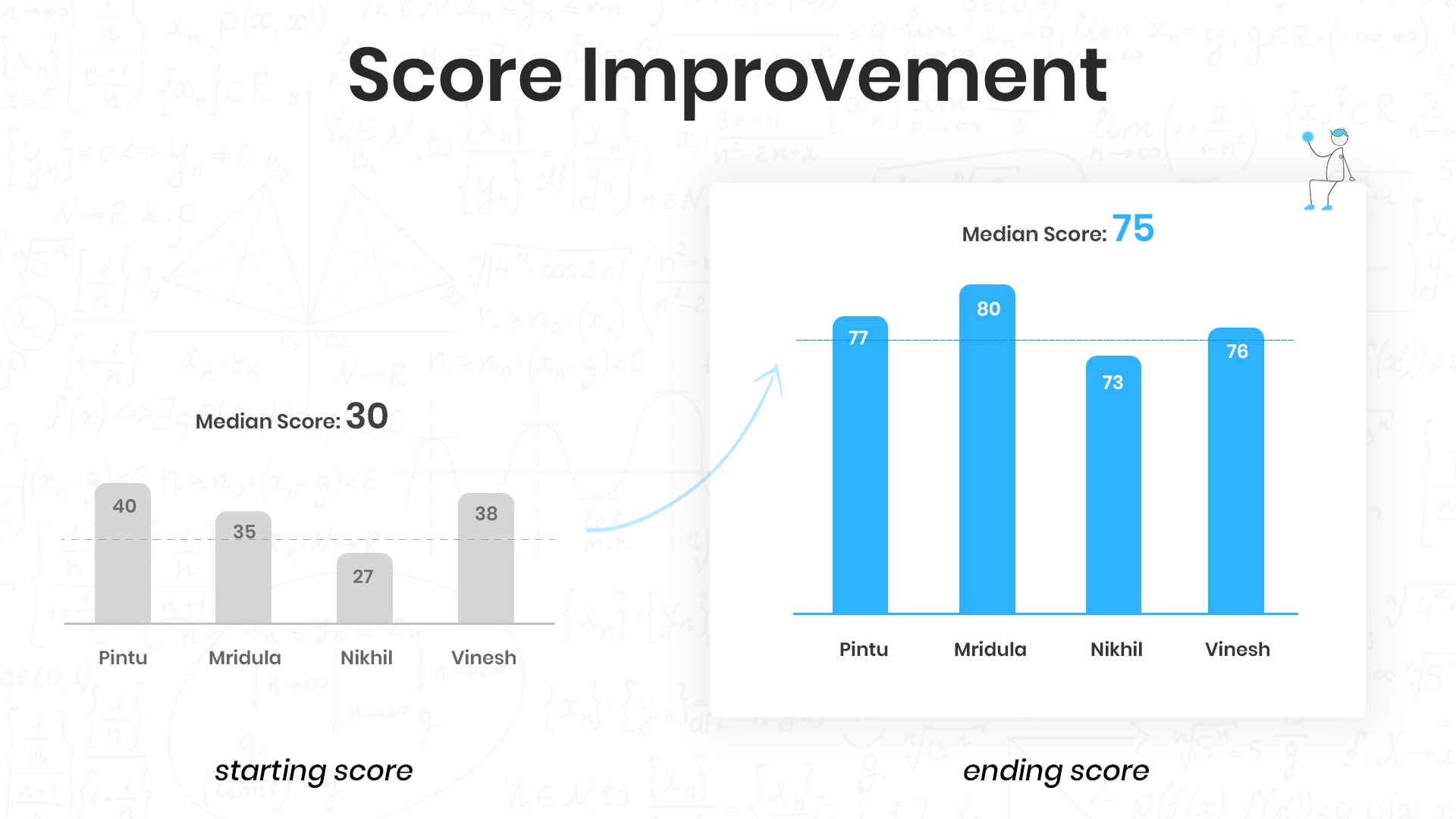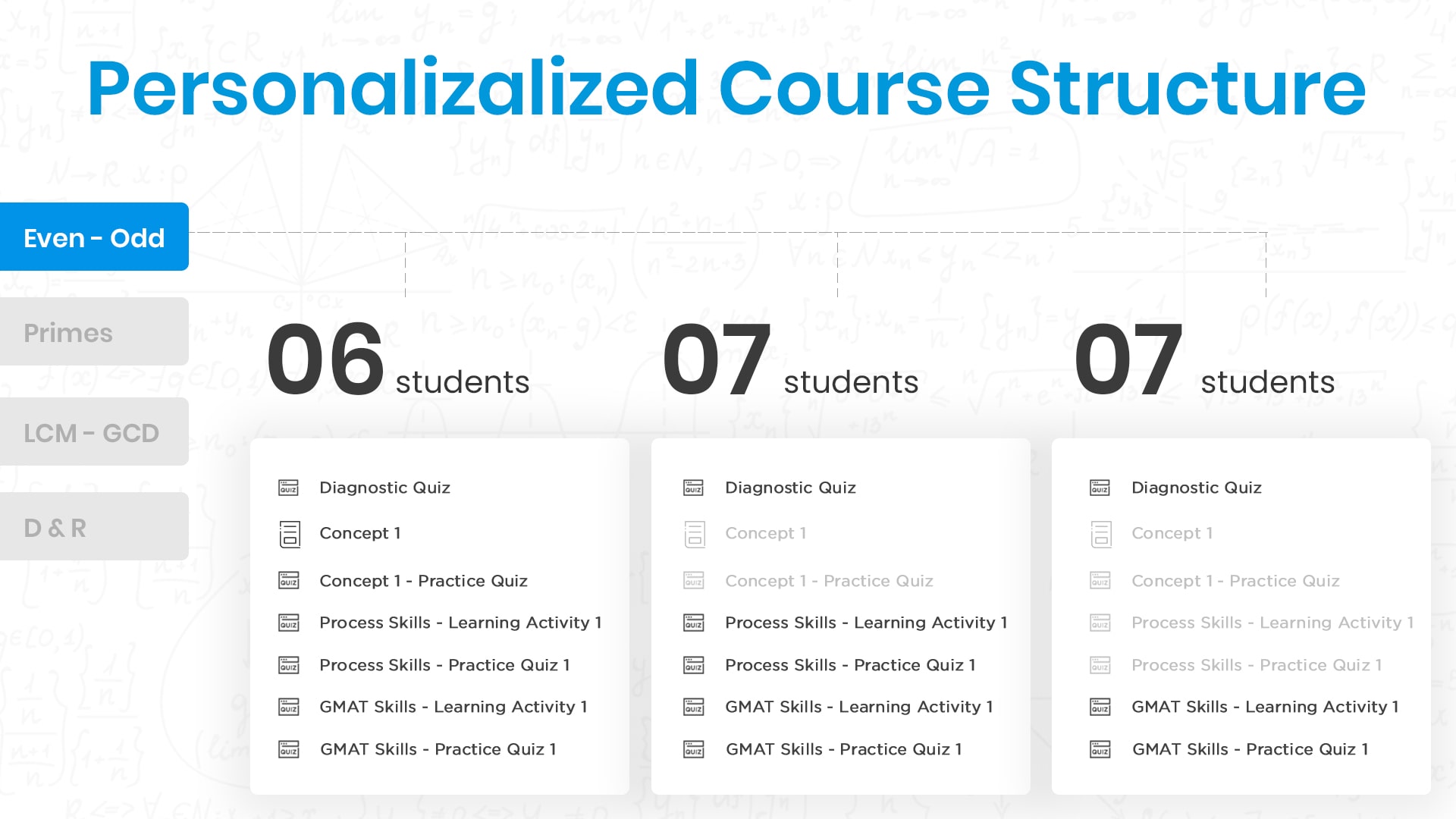10 years ago, when we launched our Sentence Correction course, it was built on two pillars – sustainable methods, i.e. methods that worked on every question, regardless of the difficulty level, and precise feedback. Two years ago, we started working on a brand-new Quant course. We just concluded a limited trial of the same. This post highlights some attributes of the Quant course and lists feedback from trial participants.
“Very beautifully, each module exposes something new which is easy to chew and apply next time so you can cement previously learned things and still learn something new each time ” – Harjas
Score improvements from the trial

Personalization
“Teach me what I need and nothing else”
According to the GMAC, most people who score 700+ spend 100+ hours preparing for the test. A good chunk of that time goes to waste as students spend time learning and relearning content that they already know.
As a result, students are unable to realize their true potential. Using granular diagnostics, Quant 2.0. solves that problem.
For example, while studying Number Properties, you will know
- Whether you need to study the Even Odd module.
- Which activities should you study in the Even-Odd module?
Overall, at launch, Quant 2.0 will offer 60 different learning paths – each path optimized to your learning needs.
At launch, Quant 2.0 will offer 60 different learning paths – each optimized to your needs

New Learning Architecture
At e-GMAT, learning architectures are our favorite pastime.
In 2010, when most books focused primarily on teaching concepts, our Sentence Correction offering contained two different architectural elements – concept files and application files.
Essentially, our courses were divided into modules, where each module contained concept and application files.
Hence, in each module, you not only learn concepts but through application files, you also learn how to apply those concepts. Over the years, we have added another element to this architecture – process files.
With the new Quant course, we have revamped this architecture. While we still teach concepts, we have segregated application files into Process Skill files and GMAT Skill files. There are three benefits with the above approach:
- Learning personalization – Greater segregation into files implies that we can personalize learning even more within a module.
- Ease of learning: A core principle in learning is that the smaller the jumps, the higher the percentage of people who will simply get it. Going from concept skills to process skills and then to GMAT skills makes this transition simpler and makes new information a lot easier to absorb.
- Granular feedback: At e-GMAT, we love causality; i.e. we always strive to tell students where they are faltering and why. This new architecture (combined with the underlying technology) allows us to provide more precise and tailored feedback.
“The same DS questions that I had tried solving earlier and couldn’t get a definitive answer to, now seem logical and doable after applying the concepts and process skills.” – Rituparna Banerjee
New Learning Elements
“Make learning fun, keep me engaged, and help me study longer”
While enhancements in learning architecture and personalization are huge, perhaps the biggest change that students will experience is in activities itself. There are three major changes here:
-
New HTML5 Activity Type
Most test takers are working professionals who study after a long day at work. Hence, in Quant 2.0 we wanted to make learning more engaging and more fun. To do so, we introduce a new HTML5 type of activity. Think of this activity type as a fun webpage that has embedded videos, integrated fun quizzes such as drag and drop, integrated flash cards, and many more interactive elements that make learning fun. Based on our research, most people will be able to extend their learning session by 20-25%.
-
New Video player
One of the most popular requests that we get from our students is “Can I get a YouTube-like player so that I can play the video at 2X speed”.
One of the biggest reasons we have not adopted an MP4 player is the lack of data and personalization.
Few MP4 players provide user-level data in a scalable and secure fashion. Fewer still provide capabilities such as bookmarking a chapter within a video or making notes against a video screenshot – capabilities that are vital to good study habits.
Hence, our design and technology teams put their heads together to create a customized video player that not only enables such capabilities but also gives us the flexibility to do future enhancements.
“The new video format is highly interactive. The concept videos were easy to understand. The fact that each of the videos was short and sharp, helped with concentration and understanding. I love the quiz, it was a fun way to check my understanding of the section I just went through” – Mabali
-
A combination of formal and informal videos
Data tells us that shorter videos lead to higher engagement while longer videos lead to more in-depth learning.
To make learning more engaging and impactful, Quant 2.0 uses both formal and informal videos. Therefore, you are likely to see videos that do their job in 5 minutes and give you a sense of accomplishment.
At the same time, you are also likely to see 15 min long videos that provide that intense learning needed to drive home a complex point.
Bottom line – in Quant 2.0 the length of the video is optimized with the goal of making learning more impactful and enjoyable.
Trackable assessments
“Don’t just tell me that I have improved… give me evidence of the same.. and give it to me frequently”
Taking mocks to evaluate if you have improved is one of the worst ways to track improvement. To give you more granular tracking options, we provide ability quizzes and cementing quizzes.
These quizzes give you personalized feedback at a sub-sectional level (e.g. Number Properties, Sentence Correction, Critical Reasoning, etc.).
In Quant 2.0 we have included enhanced this trackability 4X by adding end of module assessments. For example – the NP course is divided into 4 modules and hence has four end of module assessments. Similarly, Geometry has 5 and so on, and so forth.
The benefit –
- You get a macro level feedback within the course every 2-3 days.
- Based on this feedback, we can tailor your learning, recommending course correction.
- If you ace this module-level assessment, you can move forward with confidence.
In addition to the above, there are many other smaller enhancements such as richer summary files, richer feedback screens with assessments, etc. that you as a student will appreciate.
Overall, we have been working on and evolving this learning methodology and architecture for 2+ years.
This course is just the first embodiment of the same. While it’s been 10 years since we launched our first course.. on many counts it feels that we are just getting started.
Happy learning!!
-Rajat Sadana
If you are planning to take the GMAT, we can help you with a personalized study plan and give you access to quality online content to prepare. Write to us at acethegmat@e-gmat.com. We are the most reviewed GMAT prep company on GMAT club with more than 2490 reviews and are the only prep company that has delivered more than 700+ scores than any other GMAT club partner. Why don’t you take a free trial and judge for yourself?














